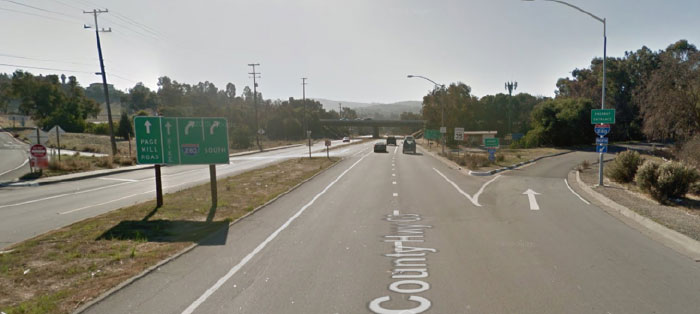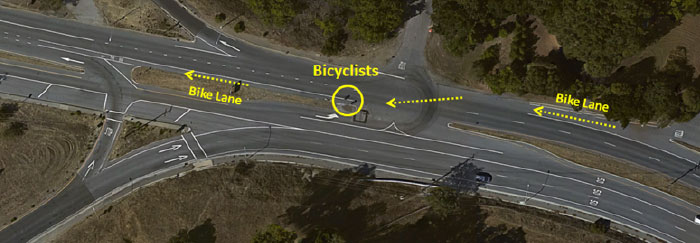On Tuesday morning, Jeffrey Donnelly of Palo Alto was tragically killed while riding a bicycle on Page Mill Road near I-280. Riding along a popular recreational cycling route, Donnelly was struck in the lane closest to the median at the tangled, horrific interchange. Donnelly is the latest victim of a status quo on the Peninsula that prioritizes speed and ignores the safety of its most vulnerable roadway users.
The Page Mill Road/I-280 interchange has an unusual, confusing design. Due to the presence of a high-speed double right turn conflict at the cloverleaf-style southbound I-280 onramp, bicyclists are instead directed to position themselves along the median. To complete this movement, bicyclists are forced to merge across two lanes of 50 MPH traffic along a highway that carries approximately 40,000 vehicles per day. The satellite aerial for Google Maps shows two bicyclists riding along the median lane.
The crossover design is confusing and unexpected, as exemplified by CHP officer Art Montiel’s lack of understanding of how the collision occurred in his statement to the San Jose Mercury News:
“It appears that somehow the vehicle and the bicyclist came into contact,” he said. “We are trying to see if the bicyclist crossed the lane and was struck by the vehicle, but that’s just speculating.”
What’s troubling about this design is that it forces a high-speed interaction between people driving at near-freeway speeds and people bicycling at much lower speeds. Every time this interaction occurs, there is a chance of a mistake. And if a mistake occurs – even if a bicyclist like Jeffrey Donnelly seemingly follows the designer’s intent – the consequences can be fatal: there is no margin of error. Moreover, the driver, a 19 year old kid, will live with the consequences of this crash for the rest of his life.
CHP Officer Moises Escoto failed to understand the underlying issues at hand in his statement to ABC7. Instead, he tried to assign blame for the crash:
“Everybody has to understand we have to share the road with the bicyclists, but also the bicyclists have to pay attention to the road signs and the vehicle code violations that also adhere to vehicles, they’re not exempt.”
We don’t know who or what exactly caused the crash, but it is clear that the roadway was not designed to be forgiving to mistakes. If Officer Escoto is looking to assign blame, a good place to start is Santa Clara County and Caltrans for designing an interchange that’s inherently dangerous.
Is this how we want to design our communities? Does it truly reflect our society’s values?
Santa Clara County has proposed $25 million in modifications to the interchange in order to enhance safety for bicyclists, but tragically the County did not act fast enough for Mr. Donnelly. We encourage all those interested in a safer Page Mill Road/I-280 interchange to get involved with the Silicon Valley Bicycle Coalition’s advocacy efforts for the project and to contact County Supervisor Joe Simitian, members of the Palo Alto and Los Alto Hills city councils, and Caltrans District 4 Director Bijan Sartipi.



